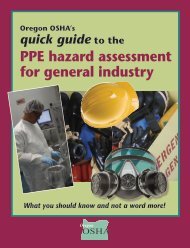Technical Manual - Section 3 (Safety Hazards)
Technical Manual - Section 3 (Safety Hazards)
Technical Manual - Section 3 (Safety Hazards)
Create successful ePaper yourself
Turn your PDF publications into a flip-book with our unique Google optimized e-Paper software.
COOLING WATER<br />
Recirculated cooling water must be treated to remove<br />
impurities and dissolved hydrocarbons. Because the water is<br />
saturated with oxygen from being cooled with air, the chances<br />
for corrosion are increased. One means of corrosion<br />
prevention is the addition of a material to the cooling water<br />
that forms a protective film on pipes and other metal surfaces.<br />
HEALTH AND SAFETY CONSIDERATIONS<br />
Fire Prevention and Protection<br />
When cooling water is contaminated by hydrocarbons,<br />
flammable vapors can be evaporated into the discharge air.<br />
If a source of ignition is present, or if lightning occurs, a fire<br />
may start. A potential fire hazard also exists where there are<br />
relatively dry areas in induced-draft cooling towers of<br />
combustible construction.<br />
<strong>Safety</strong><br />
Loss of power to cooling tower fans or water pumps could<br />
have serious consequences in the operation of the refinery.<br />
Impurities in cooling water can corrode and foul pipes and<br />
heat exchangers, scale from dissolved salts can deposit on<br />
pipes, and wooden cooling towers can be damaged by<br />
microorganisms.<br />
Health<br />
Cooling-tower water can be contaminated by process<br />
materials and by-products including sulfur dioxide, hydrogen<br />
sulfide, and carbon dioxide, with resultant exposures. Safe<br />
work practices and/or appropriate personal protective<br />
equipment may be needed during process sampling,<br />
inspection, maintenance, and turnaround activities; and for<br />
exposure to hazards such as those related to noise,<br />
water-treatment chemicals, and hydrogen sulfide when<br />
wastewater is treated in conjunction with cooling towers.<br />
ELECTRIC POWER<br />
Refineries may receive electricity from outside sources or<br />
produce their own power with generators driven by steam<br />
turbines or gas engines. Electrical substations receive power<br />
from the utility or power plant for distribution throughout the<br />
facility. They are usually located in nonclassified areas, away<br />
from sources of vapor or cooling-tower water spray.<br />
Transformers, circuit breakers, and feed-circuit switches are<br />
usually located in substations. Substations feed power to<br />
distribution stations within the process unit areas.<br />
Distribution stations can be located in classified areas,<br />
providing that classification requirements are met.<br />
Distribution stations usually have a liquid-filled transformer<br />
and an oil-filled or air-break disconnect device.<br />
HEALTH AND SAFETY CONSIDERATIONS<br />
Fire Protection and Prevention<br />
Generators that are not properly classified and are located too<br />
close to process units may be a source of ignition should a<br />
spill or release occur.<br />
<strong>Safety</strong><br />
Normal electrical safety precautions including dry footing,<br />
high-voltage warning signs, and guarding must be taken to<br />
protect against electrocution. Lockout/tagout and other<br />
appropriate safe work practices must be established to prevent<br />
energization while work is being performed on high-voltage<br />
electrical equipment.<br />
Health<br />
Safe work practices and/or the use of appropriate personal<br />
protective equipment may be needed for exposures to noise,<br />
for exposure to hazards during inspection and maintenance<br />
activities, and when working around transformers and<br />
switches that may contain a dielectric fluid which requires<br />
special handling precautions.<br />
III:2-54
















